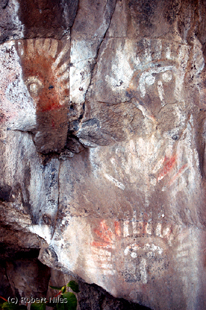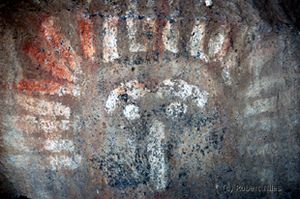Yakima Indian Painted Rocks facts for kids
Indian Painted Rocks is a small state park located just outside Yakima, Washington. You can find it where Powerhouse and Ackely Roads meet. This park is famous for its ancient rock paintings, also called pictographs. These amazing artworks are found on a cliff made of basalt rock. This cliff runs alongside what is now Powerhouse Road. Long ago, this road was an important Indian trail. Later, it became a main road for pioneers connecting the Ahtanum Valley to the Wenas Mountains.
Contents
Discovering Ancient Art
The rock paintings at Indian Painted Rocks are very old. Experts first thought they were only a few hundred years old. But now, they believe the paintings might be over 1,000 years old! Imagine, people were creating art here a thousand years ago.
How the Paintings Were Made
These pictographs were painted on the cliff when a prehistoric lake covered the bottom of the area. Native people used canoes to reach the cliff face and paint. They used natural materials from plants and minerals to make their colors.
The paintings are colorful and unique. They use white, red, and black paints. These are called polychromatic paintings because they use many colors.
A Note on Preservation
Over time, some of the paintings were changed. A person named Lucullus Virgil McWhorter tried to make them brighter using enamel paints. Today, experts agree that this method is not good for preserving ancient art. It can actually harm the original paintings. Modern preservation focuses on protecting the art as it is.
History of the Park
The land for Indian Painted Rocks State Park was acquired in 1950. It was purchased from the Yakima Valley Canal Company.
What the Park Sign Says
At the park's entrance, there's a sign from the Washington State Highway Commission. It shares interesting facts about the paintings and the area:
- No one knows for sure who made these paintings. Even today's Native American tribes in the area don't know their exact origin.
- These paintings are similar to many others found across western North America.
- They might show religious experiences or record important events. These events could include hunts or meetings with other tribes.
- This location was part of an old Indian trail. This trail went from the Wenas Mountains to the Ahtanum bank of the Yakimas.
- In the 1850s, miners used this same trail. They were traveling to find gold in British Columbia.
- Later, as American settlers moved into the Yakima Valley, a stagecoach route also passed by these cliffs.
Protecting the Paintings
In early 2007, the state parks department had to close Indian Painted Rocks park. This was because of graffiti, which is when people draw or write on public property without permission. Graffiti can damage these precious ancient artworks.
There are plans to change the park's layout. The goal is to better protect the painted rocks from harm. This will help make sure future generations can also see and learn from this important historical site.



